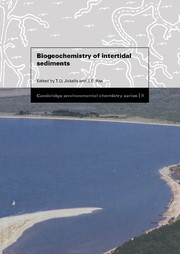Book contents
- Frontmatter
- Contents
- List of contributors
- Preface
- 1 Biogeochemistry of intertidal sediments
- 2 Trace metals in deposited intertidal sediments
- 3 Modelling adsorption and desorption processes in estuaries
- 4 A critical appraisal of the methodology used in studies of material flux between saltmarshes and coastal waters
- 5 Nutrient recycling in intertidal sediments
- 6 An overview of carbon and sulphur cycling in marine sediments
- 7 Microbial activity and diagenesis in saltmarsh sediments, North Norfolk, England
- 8 The behaviour of radionuclides in the coastal and estuarine environments of the Irish Sea
- 9 The sorption of hydrophobic pyrethroid insecticides to estuarine particles: a compilation of recent research
- Index
9 - The sorption of hydrophobic pyrethroid insecticides to estuarine particles: a compilation of recent research
Published online by Cambridge University Press: 23 September 2009
- Frontmatter
- Contents
- List of contributors
- Preface
- 1 Biogeochemistry of intertidal sediments
- 2 Trace metals in deposited intertidal sediments
- 3 Modelling adsorption and desorption processes in estuaries
- 4 A critical appraisal of the methodology used in studies of material flux between saltmarshes and coastal waters
- 5 Nutrient recycling in intertidal sediments
- 6 An overview of carbon and sulphur cycling in marine sediments
- 7 Microbial activity and diagenesis in saltmarsh sediments, North Norfolk, England
- 8 The behaviour of radionuclides in the coastal and estuarine environments of the Irish Sea
- 9 The sorption of hydrophobic pyrethroid insecticides to estuarine particles: a compilation of recent research
- Index
Summary
Introduction
Intertidal sediments, especially fine-grained estuarine sediments, may be a net sink, or at least a transient repository of hydrophobic organic chemicals (HOC) from a number of sources. HOC have a strong, though variable, affinity for sediment minerals, especially for clays coated with natural organic matter (OM). Measurement of this adsorptive capacity is thus an important goal for geochemists wishing to study the budget and fate of HOC in the intertidal environment.
Although a considerable literature of adsorption measurements exists, the cocktail of HOCs which reaches estuarine waters is so diverse and originates from so many sources (including from municipal discharges, from effluents from industrial works sited on estuaries, and from riverine inputs) that inevitably there are important gaps in our knowledge. Included in this is information about a number of important agrochemical HOCs which may enter estuaries, via riverine transport. This chapter focuses particularly on one group of HOCs (pyrethroids), the chapter by Turner and Tyler discusses the behaviour of some other groups.
The pyrethroid agrochemicals represent a quarter of the world insecticides market and are widely used in the UK, continental Europe, the USA and elsewhere as household, public health and agricultural insecticides (Hill, 1989; Perrior, 1993). The chemicals are described by the generic name ‘pyrethroids’ because they are all man-made analogues of the esters of the natural cyclopropanoic acid, chrysanthemic acid, found in the plant family pyrethrums, but in fact they exhibit a range of physico-chemical properties in the environment.
- Type
- Chapter
- Information
- Biogeochemistry of Intertidal Sediments , pp. 173 - 188Publisher: Cambridge University PressPrint publication year: 1997



